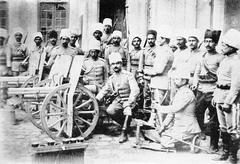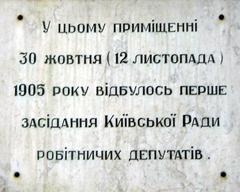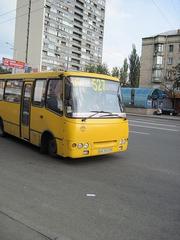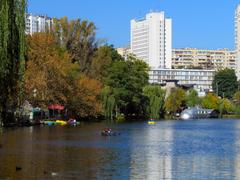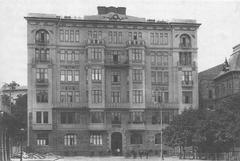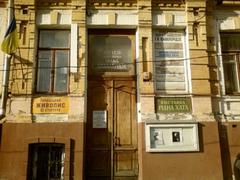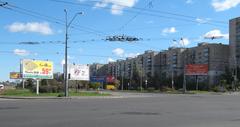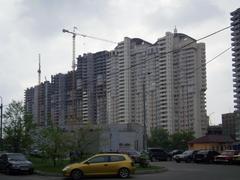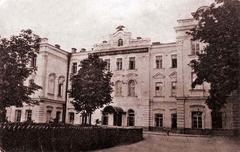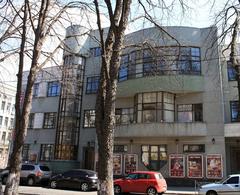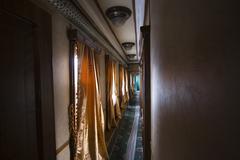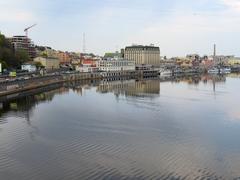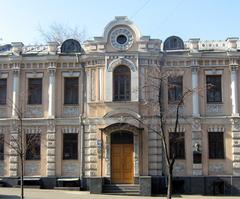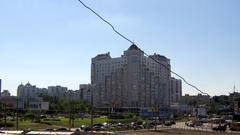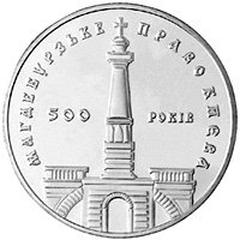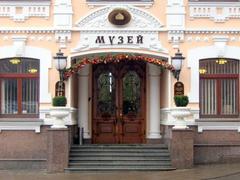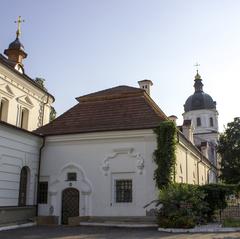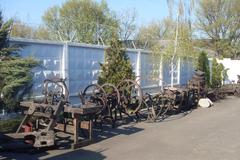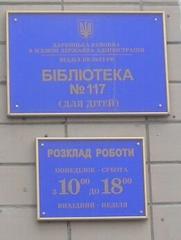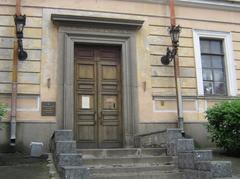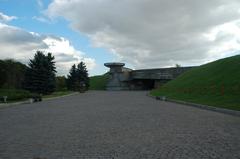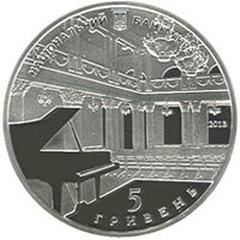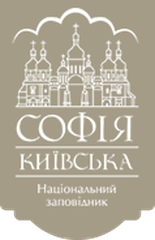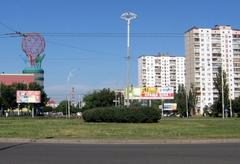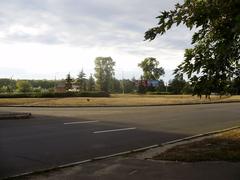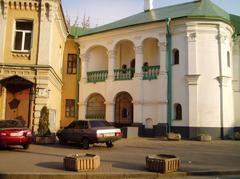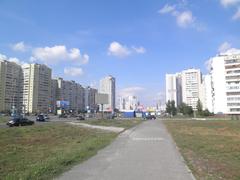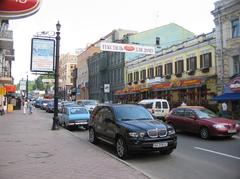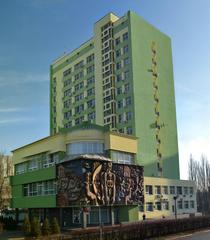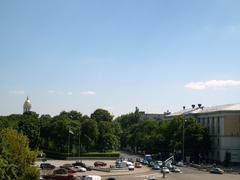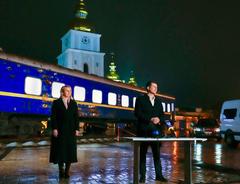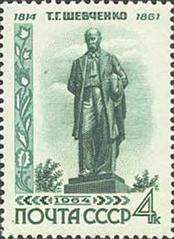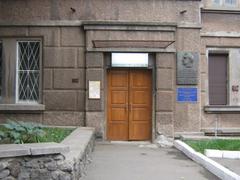
Kyiv-Mohyla Academy Old Academic Building: Visiting Hours, Tickets, and Historical Significance in Kyiv
Date: 03/07/2025
Introduction
The Kyiv-Mohyla Academy Old Academic Building, located in Kyiv’s storied Podil district, is a cornerstone of Ukraine’s educational and cultural heritage. Founded in the early 17th century, the Academy and its iconic building—often called Mazepa’s Building—have shaped the intellectual and spiritual life of Ukraine and Eastern Europe for nearly four centuries. The structure stands as a striking example of Ukrainian Baroque architecture, blending Western European influences with Orthodox and local traditions (visitukraine.today, Library of Congress).
This guide provides a comprehensive overview of the Academy’s history, architectural highlights, visitor information, and practical tips for experiencing one of Kyiv’s most treasured historical sites.
Table of Contents
- Early Foundations and Establishment
- Architectural Evolution and Features
- Educational and Cultural Significance
- Periods of Closure and Revival
- Visiting Hours and Tickets
- Accessibility and Guided Tours
- Events and Cultural Activities
- Nearby Attractions and Visitor Tips
- FAQ
- Conclusion
- References
Early Foundations and Establishment
The roots of the Kyiv-Mohyla Academy stretch back to 1615, when Halshka Hulevychivna donated her property to establish a monastery, hospital, and school for Kyiv’s gentry and merchant children (Academia.edu). The school evolved into the Kyiv Brotherhood School and, by 1632, merged with the Lavra School under the guidance of Petro Mohyla. This new institution became the first university in Ukraine and quickly developed a reputation as a beacon of learning and Orthodox spirituality (UATV).
Construction of the Old Academic Building began in 1703–1704 under the patronage of Hetman Ivan Mazepa. Designed in the Ukrainian Baroque style, it initially comprised a single story with six classrooms, three entrance halls, and a gallery with nine arches (vm.ukma.edu.ua).
Architectural Evolution and Features
Ukrainian Baroque Splendor
The Old Academic Building embodies the Ukrainian Baroque style—characterized by ornate facades, decorative pediments, and rhythmic arches (readingkyiv.net). In the 1730s, Johann Gottfried Schädel added a second floor, enhancing both its presence and functionality.
Key features include:
- Stucco Facades and Pilasters: The building’s whitewashed walls, pilasters, and cornices create an elegant yet imposing impression.
- Baroque Pediments: The central entrance, topped with a Baroque pediment, serves as a symbolic “gateway to knowledge.”
- Vaulted Ceilings: High, vaulted lecture halls maximize light and air, creating a scholarly atmosphere.
- Historic Interiors: Early 18th-century fresco-adhesive paintings—a rarity in Kyiv, comparable only to those in the Kyiv-Pechersk Lavra and St. Sophia Cathedral—adorn the interiors (vm.ukma.edu.ua).
The use of local brick, stone, and wood reflects the region’s resources and craftsmanship.
Educational and Cultural Significance
From its inception, the Academy was dedicated to higher education, offering a curriculum that combined theology, philosophy, languages, and natural sciences. It became a crucible for Ukrainian, Russian, and Eastern European intellectuals, with alumni including hetmans Ivan Mazepa and Pylyp Orlyk, philosopher Hryhorii Skovoroda, and scientist Mikhail Lomonosov.
The Academy’s educational innovations—such as introducing Western philosophical approaches and fostering civic values—profoundly shaped Ukrainian consciousness and regional intellectual traditions. Even during periods of suppression, the Academy remained a symbol of cultural resilience (Academia.edu).
Periods of Closure and Revival
The Academy’s fortunes mirrored Ukraine’s turbulent history. After flourishing in the 17th–18th centuries, it faced closure under the Russian Empire and was repurposed during the Soviet era. In the 1920s, the Old Academic Building housed the National Library of Ukraine’s collections. Following Ukraine’s independence, the Academy was revived and officially reopened in 1992, resuming its mission as a center of learning and culture (UATV).
Recent restoration projects, including a $405,000 U.S.-funded initiative in 2019, have preserved its architectural integrity while modernizing facilities for students and visitors (U.S. Embassy).
Visiting Hours and Tickets
- Location: Podil district, easily reached via Kontraktova Ploshcha metro station.
- Visiting Hours: Tuesday–Sunday, 10:00 AM–6:00 PM; closed Mondays and public holidays.
- Tickets: General admission is 100–150 UAH; discounts are available for students, seniors, and groups. Children under 7 enter free. Tickets are available onsite or online via the official website.
Note: Some events and guided tours require separate tickets.
Accessibility and Guided Tours
Recent renovations have improved accessibility, with ramps and elevators serving most public areas. Guided tours are offered daily in Ukrainian, English, and Russian, providing insights into the building’s history, architecture, and cultural impact. Advance booking is recommended, especially during peak seasons or for group visits.
Events and Cultural Activities
The Academy regularly hosts academic conferences, exhibitions, concerts, and public lectures in both the Old Academic Building and the Congress Hall. Major annual events include Foundation Day, historical reenactments, and open-air performances. The Academy also played a visible role during the Orange Revolution, underscoring its ongoing civic engagement.
Nearby Attractions and Visitor Tips
The Podil district is rich in historical and cultural landmarks:
- Kontraktova Square: A hub of local life, shops, and restaurants.
- Andriyivskyy Descent: Famous for its arts scene and historic architecture.
- Kyiv River Port: A picturesque spot for riverside walks.
- Blahovishchenska (Annunciation) Church: Part of the Academy complex, featuring 300-year-old ornaments.
Visitor Tips:
- Arrive early to avoid crowds.
- Dress comfortably, as interiors can be cool.
- Photography is allowed in most areas (without flash); restrictions apply in the Annunciation Church.
- Respect the Academy’s status as an active university campus.
Frequently Asked Questions (FAQ)
Q: What are the Kyiv-Mohyla Academy visiting hours?
A: Tuesday to Sunday, 10:00 AM–6:00 PM; closed Mondays and public holidays.
Q: How much are tickets?
A: 100–150 UAH for general admission, with discounts for students and seniors.
Q: Is the building wheelchair accessible?
A: Main areas are accessible; some upper floors or historic sections may have limited access.
Q: Are guided tours available in English?
A: Yes, English-language guided tours are offered daily.
Q: Can I take photos inside?
A: Photography is permitted without flash in most exhibition areas; restrictions apply in the church.
Q: How do I get there?
A: Metro (Kontraktova Ploshcha), bus, tram, taxi, or ride-hailing apps.
Conclusion
A visit to the Kyiv-Mohyla Academy Old Academic Building offers a vivid journey through Ukraine’s educational, cultural, and architectural legacy. From its Baroque splendor and academic innovations to its role in modern civic life, the Academy is a living monument that continues to inspire. Plan ahead by checking the latest visiting hours and ticket options on the official website, and consider using audio guides or apps for an enhanced experience. Don’t miss the opportunity to explore not just the Academy, but the vibrant Podil district and other Kyiv historical sites.
For further updates, event schedules, and travel tips, follow the Academy on social media and download the Audiala app for interactive guides.
References
- visitukraine.today
- Library of Congress
- UATV
- official Kyiv-Mohyla Academy website
- U.S. Embassy
- Reading Kyiv
- Academia.edu








